30 Fun Facts about Paella
The popular and famous dish paella holds a special place in the hearts of food lovers across the globe. This dry rice dish which is originated in the Valencia region on Spain’s Mediterranean coast, carrying with it centuries of culinary heritage.
The first documented recipe appeared in the 18th century, marking the moment when paella began to gain popularity across Spain. Originally known as paella Valenciana, the dish used ingredients like chicken, rabbit, vegetables, and rice which creates an authentic flavor. Over time, modern variations, including seafood paella, emerged, showcasing the versatility of this humble yet beloved dish.
The Name “Paella”: What Does It Mean?
In its early days, paella was a meal for farmers and farm labourers, cooked over a wood fire using whatever was available. Ingredients like onions, tomatoes, snails, and beans brought a delightful mix of flavour and texture to the dish. Sometimes, they added rabbit, duck, or chicken for extra richness and a taste of saffron for its distinct color and taste. Traditionally, they served it straight from the pan, with each person using their own wooden spoon to enjoy it.
The name “paella” itself has intriguing origins. It is derived from the cooking pan the very heart of the dish used in its preparation. This term traces back to old Valencian, a language similar to Catalan, with roots in the Latin word “patella,” meaning pan. Some believe it may also stem from the Arabic word “Baqiyah,” which means “leftovers,” emphasizing the dish’s humble beginnings and its practical use of available ingredients.
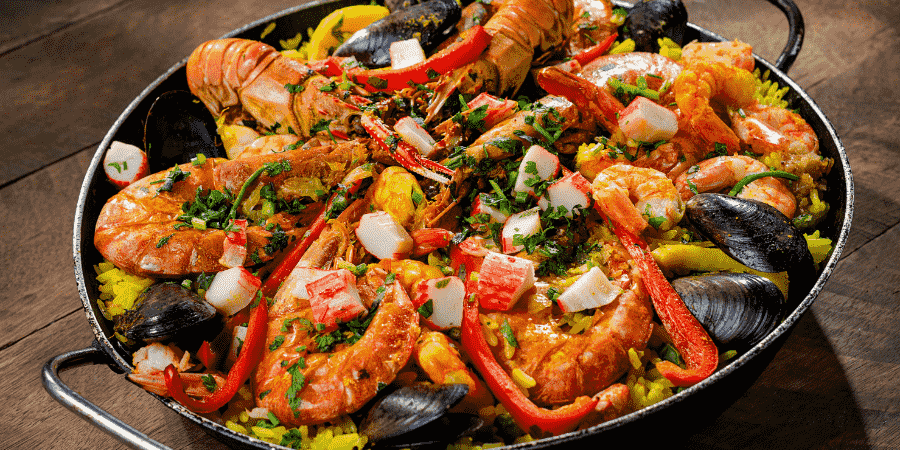
Over time, as “Valencian rice” became widely available, new variations of paella emerged, which showcased the creativity of cooks in adapting the traditional recipe. Today, whether it’s a special occasion with chicken and saffron or a unique take with seafood or extra vegetables, the authenticity and charm of paella remain unmatched. Its journey from humble origins to a globally famous dish highlights its timeless appeal and versatility.
Facts about Paella
Here are 31 facts about paella you should know before you order it next time.
#1. The Origins of Paella
Paella originated on Spain’s east coast, specifically in Valencia, a beautiful Mediterranean city. Its roots trace back to small fishing villages near Lake Albufera, about 20 km south of Valencia. They first cooked the dish in the charming village of El Palmar, nestled within Albufera National Park, surrounded by sprawling rice fields spanning 220 km².
Today, El Palmar is a culinary hotspot with 30+ restaurants serving incredible paella which makes it a must-visit for food enthusiasts. If you’re planning a trip to Valencia, a visit to this village promises an authentic paella experience amid its serene surroundings.
Fun Facts about Paella: Paella’s birthplace, El Palmar, continues to follow its centuries-old traditions of preparing the meal in its original form.
#2. The Unmistakable Paella Valenciana
You’ll find exactly ten ingredients for an authentic taste of paella Valenciana: bomba rice, chicken, rabbit, water, green beans, tomatoes, olive oil, garrofó beans, saffron, and salt. This original recipe holds the prestigious Denomination of Origin which ensures its quality and adherence to tradition.
While some variations may include artichokes, snails, or rosemary, straying too far from these ingredients makes it no longer a true paella Valenciana. If you ever get a chance to try this classic dish, expect the perfect balance of flavors in every bite.
Exploring the birthplace of paella is a culinary journey and a cultural experience. This offers insights into Spain’s rich history and love for food.
Fun Facts about Paella: In Valencia, the law protects the authenticity of paella Valenciana; any variation from the original recipe is deemed fake.
#3. Unconventional Beginnings: The First Paella Recipe
The first published paella recipe in 1857 featured some surprisingly unorthodox ingredients. It included pork loin, sausage, garlic, red pepper, parsley, peas, and even eel! While these additions may sound delicious, modern-day purists often consider them a culinary sacrilege, far removed from the authentic paella Valenciana.
This unexpected combination highlights the evolution of paella from a practical peasant dish to the refined, celebrated meal we know today. It’s fascinating to see how the journey of paella began with such diverse elements. This reflects the resourcefulness of its early creators.
#4. Is Paella Spain’s National Dish?
Paella is often mistaken as the country’s national dish outside Spain, but the truth might surprise you. For many Spaniards, paella is seen as a dish from Valencia. This is deeply rooted in its regional identity rather than as a symbol of Spain as a whole.
Interestingly, Spain does not have an official national dish, though some argue that tortilla de patatas (Spanish omelette) holds this title unofficially. Paella’s fame skyrocketed in the 19th century when people served it at international fairs, diplomatic meetings, and major conferences, cementing its status as an internationally recognized Spanish delicacy.
Travelling through Spain reveals countless paella variations, many of which stray from the original recipe. However, for Valencianos, these modern adaptations often fail to capture the essence of what makes their regional specialty so iconic.
Fun Facts about Paella: Although it is well-known world-wide, Valencians view paella as a regional cuisine rather than Spain’s national dish.
#5. A Good Paella: Worth the Wait
Patience is key to a truly authentic paella experience. Unlike the ready-made versions you might find in markets or takeaway spots, people always make a proper paella to order. The rice layer in authentic paella is thin. This allows for the coveted socarrat—the crispy, caramelized layer at the bottom of the pan.
Cooking an authentic paella typically takes 40 to 50 minutes, just enough time to enjoy a leisurely starter. Once cooked, they allow the paella to rest for five minutes before serving to ensure the flavors are perfectly melded. For Spaniards, dining is a slow, social experience, so this slight wait is part of the joy.
#6. Straight from the Pan: A Traditional Paella Experience
Traditionally, people serve paella directly in the pan it was cooked in, placing it in the center of the table for everyone to share. This rustic presentation reflects the dish’s humble origins by emphasizing community and simplicity over formality.
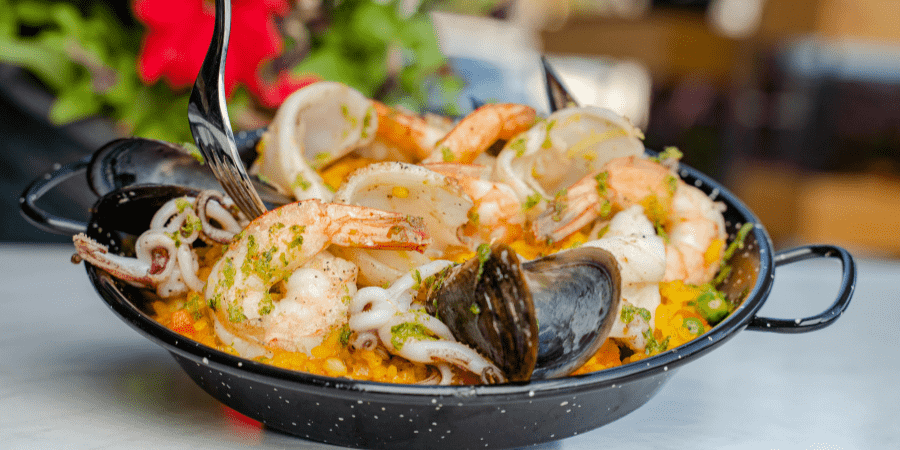
In many Valencian households, diners still eat straight from the pan using a spoon, which people say enhances the taste. While modern restaurants may offer individual plates, embracing this communal style is the key to experiencing paella the traditional way.
#7. The Best Part of Paella: The Socarrat
One of the most celebrated aspects of paella is the socarrat, a slightly caramelized layer of rice at the bottom of the pan. The term “socarrat” comes from the Valenciano word for “burnt,” but don’t let that fool you. This layer isn’t burnt but perfectly crispy, offering an incredible depth of flavor.
To fully enjoy the socarrat, using a spoon rather than a fork is best. This allows you to scrape the pan and capture every layer of the dish, from the tender rice to the crispy socarrat. Many consider a paella without socarrat incomplete, as this layer distinguishes a truly exceptional paella from an ordinary one.
Fun Facts about Paella: Since the socarrat is regarded as the best and most savory component of the paella, some Valencian families quarrel over who gets to eat it.
#8. The Perfect Paella: Thin and Flavorful
A key feature of authentic paella is its thin layer of rice, cooked to perfection in a shallow pan. The ideal rice layer is no more than 2 cm (0.8 inches) deep, which ensures even cooking and the development of the coveted socarrat. Paella pans, typically 7 cm (2.75 inches) deep, are designed to achieve this balance.
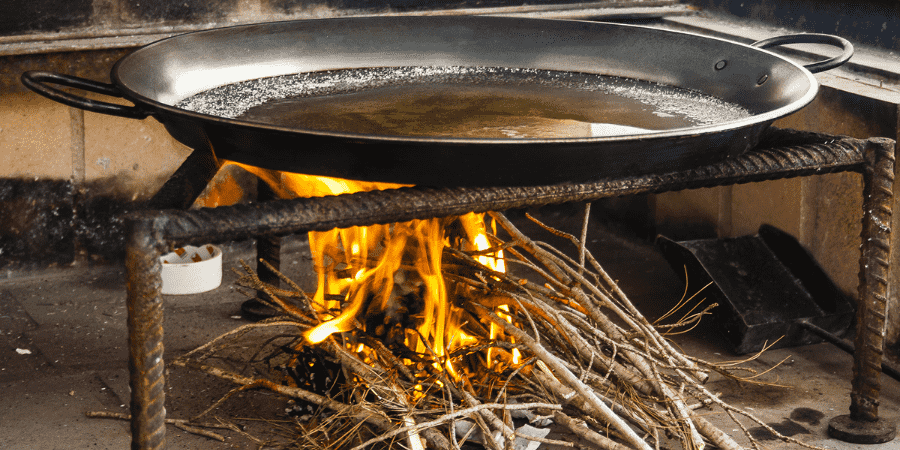
Rice cooked in a thin layer allows for a more intense flavor and better texture that makes it a hallmark of the best paellas. Anything thicker and the dish risks losing its signature taste and texture.
Fun Facts about Paella: This word comes from the Old French word paelle, which meaning “pan.” The Latin word patella, which denotes a flat plate or dish, is the source of this.
#9. Humble Origins: Paella’s Simplicity
The simplicity of paella roots in its humble beginnings. Peasants in the Valencia region created it long before the Industrial Revolution. Using ingredients they had on hand like rice grown in Albufera since the 8th century. Peasants crafted a dish that was practical, filling, and delicious.
This explains the minimalist nature of traditional paella recipes, which rely on a handful of fresh, locally available ingredients. These origins also account for the variety of rice-based dishes in the region which reflects a deep cultural connection to this staple food.
Fun Facts about Paella: The authenticity of paella lies in its dependence on basic, fresh ingredients, and many of the recipes haven’t altered since it was first made.
#10. Paella Is Always Prepared for an Even Number of People
People always make paella for an even number of people, and its preparation follows a unique tradition. This practice stems from the size and design of the paella pan, which dictates the proportions for two, four, six, or more servings. Attempting to add rice for an odd number of diners would result in a too-thick layer, which may compromise the flavor and texture of the dish.
Fun Facts about Paella: People believe that an even group sharing paella preserves the dish’s harmony of flavors and textures, ensuring everyone gets an equal share of its delicious components.
#11. Paella Has Its Own Day
People love paella so much that it has not one but two dedicated days of celebration!
- The United States recognizes March 27th as National Spanish Paella Day.
- Spain and other countries celebrate November 20th as World Paella Day to honor the cultural and culinary significance of this iconic dish
#12. Paella: The Quintessential Dry Rice Dish
Unlike risotto, paella is a dry rice dish. This means that the rice should be perfectly cooked, with no residual broth or clumps, by the time people serve it. The goal is for individual grains of rice to be flavorful and evenly cooked without a creamy or soupy consistency.
For those who enjoy less-dry rice dishes, Valencia offers alternatives like arroz caldoso (brothy rice) and arroz meloso (creamy, yet not as dry as paella).
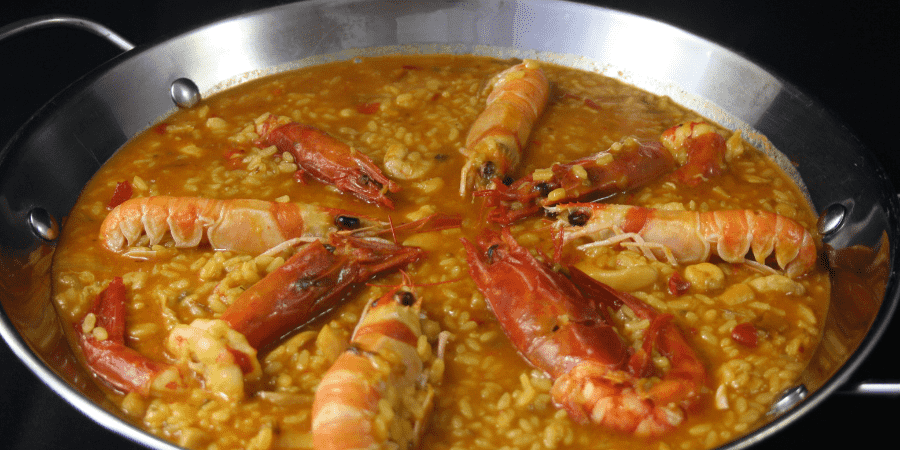
Fun Facts about Paella: One key feature that sets paella apart from other rice dishes is its dry texture, which highlights the individual grains that absorb all of the dish’s flavors.
#13. The Paella Emoji: A Culinary Icon
Paella is the first Spanish dish to have its own emoji, introduced in 2016. Initially, it featured shrimp, peas, and mussels—ingredients that do not align with the authentic paella Valenciana recipe. Valencianos made considerable effort to set the record straight, leading to redesigning the emoji to include chicken, green beans, and garrofó beans, reflecting the traditional recipe.
Today, this emoji is a cultural tribute to the dish’s rich heritage and global popularity.
Fun Facts about Paella: The paella emoji has gained international recognition as a representation of Spanish food and cultural pride.
#14. The Largest Paella Fed 110,000 People
In 2001, Valencian chef Antonio Galbis and his team broke the Guinness World Record for the largest paella ever made. They cooked this gigantic dish in Madrid and served an astonishing 110,000 people. The paella pan had a diameter of 21 meters (69 feet) and required:
- 6,000 kg (13,227 lbs) of rice
- 12,500 kg (27,557 lbs) of meat
- 30 tons of orange and pine branches for the fire
While achieving socarrat (the caramelized bottom layer) was likely impossible on this scale. The paella was prepared with traditional ingredients and techniques.
#15. The Best Paella Is Cooked Over an Open Fire
The most authentic paella is cooked over an open fire, often using orange branches for fuel. This method gives the dish a unique, smoky flavor. In Valencia, people traditionally prepare paella in a paellero, a built-in barbecue, or on the streets during festivals like Las Fallas, using a wrought iron tripod to support the pan.
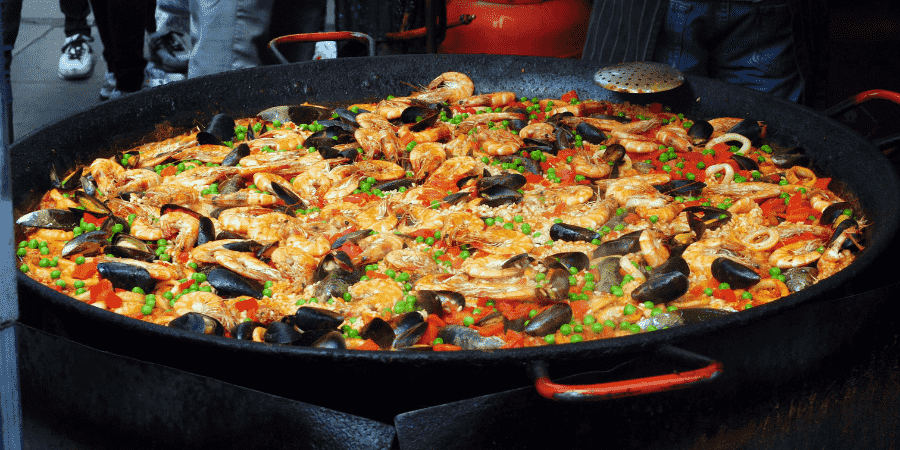
While most modern restaurants use gas stoves for convenience, some still adhere to this time-honoured practice. This offers diners an unparalleled taste experience.
Fun Facts about Paella: The paella’s smoky scent, which is hard to imitate on contemporary stoves, comes from the open-fire cooking method, especially when orange branches are used.
#16. Spaniards Enjoy Paella Exclusively at Lunchtime
People traditionally consider paella a lunchtime dish in Spain. Its hearty nature makes it too heavy for dinner, especially given Spain’s late dining hours and preference for lighter evening meals.
Although tourists might enjoy paella for dinner, locals typically savor it during lunch. This makes it the perfect centerpiece for a leisurely midday meal.
Fun Facts about Paella: The Spanish way of life, in which lunch is the primary meal of the day and frequently consists of shared, communal dishes like paella, is consistent with the lunchtime paella tradition.
#17. Paella is a Festive Dish
Paella holds a special place in Spanish culture, particularly in Valencia, where people see it as a dish that brings them together. The tradition of gathering around a paella on Sundays is common for family reunions which makes it a symbol of communal celebration.
Restaurants often include paella as part of the menu del día (menu of the day) on Thursdays, highlighting its importance in Spanish dining culture.
#18. Stirring Paella is Forbidden
A key rule of making paella is never stirring the rice after adding the broth. This may sound unusual, but in the Valencian tradition, stirring disrupts the absorption of rice flavors and prevents the formation of the socarrat—the prized caramelized layer at the bottom of the pan. Stirring also leads to a creamy consistency, which is characteristic of risotto, not paella. So, if you’re serious about being a “paellero,” avoid this temptation!
#19. Paella in Valencia is Served with Lemon Wedges
In Valencia, it is common to serve paella with a quartered lemon on the side. This allows diners to squeeze fresh lemon juice on their paella, which enhances the flavours. While the addition of lemon is optional, many locals enjoy the tangy brightness it adds.
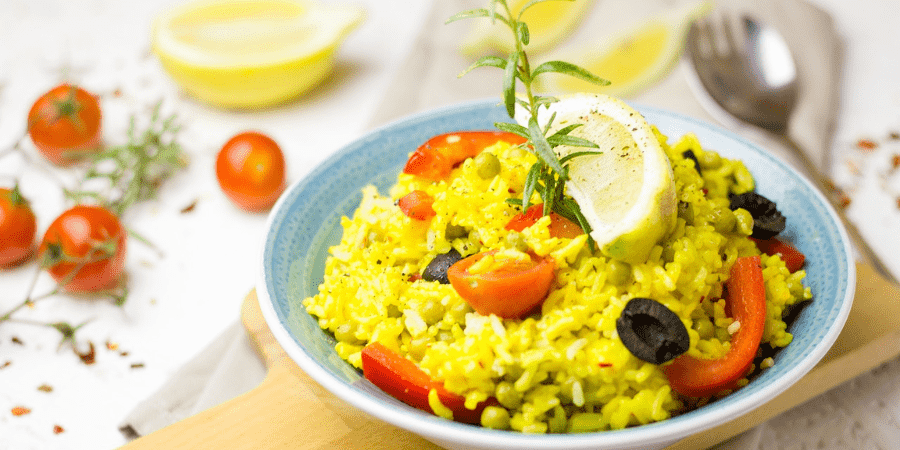
#20. No Chorizo in Authentic Paella
Contrary to popular beliefs and recipes (including Jamie Oliver’s), authentic paella Valenciana does not contain chorizo. Spaniards consider adding chorizo, along with other ingredients like carrots, onions, or garlic, almost sacrilegious.
Fun Facts about Paella: Paella purists contend that the dish’s essence is compromised by the addition of chorizo and other unconventional ingredients.
#21. The Debate on What Constitutes True Paella
Paella is more than just a dish; it symbolizes Valencian identity and pride. For many Valencianos, the only true paella is paella Valenciana. Any variation whether it’s seafood paella, mixed paella (paella mixta), or vegetable paella. It is considered just “rice with stuff” and not a genuine paella. This view emphasizes that straying from the original recipe should lead to a different name, not “paella.”
#22. The Notion That “Not All Rice is Paella”
The sentiment that not all rice dishes can be called paella is widely shared in Valencia. Locals stress that deviations from the traditional recipe mean it’s better to call the dish “rice with stuff.” This opinion highlights that paella is a dish of specific ingredients and preparation, and anything else risks misleading those familiar with the original.
This idea contrasts with other parts of Spain, where people are more tolerant. This makes it common to find less authentic, sometimes mediocre, paella.
Globally, interpretations of paella vary widely, fueling misconceptions about what qualifies as true paella. The Jamie Oliver chorizo controversy is an infamous example. His recipe with chorizo and peas provoked strong reactions from Spaniards, who even likened it to an offense akin to those suffered during the Spanish Civil War.
#23. Choosing the Right Rice for Paella
The type of rice used is crucial for making authentic paella. People consider bomba rice the most traditional choice, known for its excellent ability to absorb flavors while remaining firm.
Different varieties, like senia or bahía, are also suitable. People should never use long-grain and aromatic rice varieties, as they don’t absorb flavors properly. This results in a dish that lacks the true essence of paella.
#24. Paella and Its Quest for UNESCO Recognition
Paella is on the path to potentially becoming a UNESCO Intangible Cultural Heritage of Humanity. In 2021, the Valencian government declared paella an Asset of Intangible Cultural Interest. This signals the beginning of a longer process to seek UNESCO recognition.
This move follows examples like Neapolitan pizza, which took Italy over eight years to have added to the list. The aim of the recognition is not only to honor paella’s cultural significance but also to ensure protections at the EU level. This prevent misuse of the name, which could lead to consumer confusion.
#25. Pronunciation of “Paella”
An interesting and often overlooked detail is the correct pronunciation of “paella.” It should be pronounced “pah-EH-yah”, with emphasis on the second syllable and the “ll” sounding like a “y.” Common mispronunciations include “pie-EL-uh” or “pai-EH-luh,” but getting it right can show a deep respect for the dish and its cultural roots.
#26. Celebrating World Paella Day
Another amazing fun Fact of Paella is that it has earned its place on the global calendar, with World Paella Day celebrated annually on September 20th. Additionally, the U.S. observes National Spanish Paella Day on March 27th, which gives people multiple reasons to enjoy this iconic dish.
#27. The “Paellera” – The Essential Paella Pan
People call the distinctive, large, shallow pan used for cooking paella a “paellera” in Spanish. Its wide surface area is key to creating the iconic thin layer of rice and the prized socarrat at the bottom. In Valencia, it’s common to refer to both the dish and the pan simply as “paella”. This emphasize their integral connection.
#28. The Global Fame of Seafood Paella
Seafood paella has gained significant recognition outside of Spain, largely due to the impact of tourism. While paella Valenciana holds the title as the traditional version of the dish. This seafood paella has become popular in coastal tourist areas and international culinary scenes.
This variation typically features ingredients like shrimp, mussels, squid, and other seafood. Thus, making it an attractive option for visitors looking to experience Mediterranean flavors
#29. The Moorish Origins of Paella
The roots of paella trace back to Moorish culture, which introduced rice to Spain during their rule from the 8th to 15th centuries. The fertile, marshy lands around Valencia provided the perfect environment for rice cultivation. This created the conditions that would later contribute to the development of what we now know as paella.
#30. Creative Global Variations of Paella
The influence of Paella extends beyond Spain, inspiring chefs around the world to experiment and put their unique twist on the dish. From incorporating coconut milk in Southeast Asia to adding Cajun spices in Louisiana, these adaptations highlight how paella has evolved globally.
While these variations may take on different flavors and ingredients, they still showcase the essence of paella as a dish that brings together culture and community.
Final Thoughts about Paella
Paella is more than just a dish; it’s a vibrant symbol of Spanish culture and culinary heritage that has captivated food lovers worldwide. Local communities in Valencia rooted its origins in tradition and resourcefulness. This showcases how simple, accessible ingredients can come together to create extraordinary flavors. Whether enjoyed as a communal meal with friends and family or transformed with creative twists in various parts of the world. Paella celebrates togetherness, innovation, and a profound appreciation for high-quality ingredients.
People explore its rich history, appreciate its cultural significance, and study the diverse ways it has been adapted globally. We not only honor paella’s legacy but also embrace the universal joy of sharing a meal that unites people. Every paella cooked or savored is a reminder of the beauty of culinary traditions that transcend borders and continue to inspire. Bon profit!

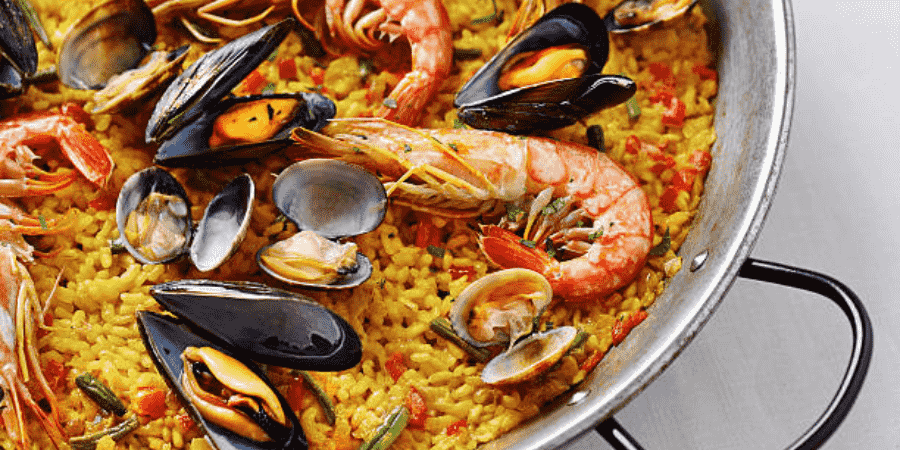
No responses yet